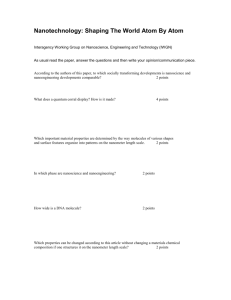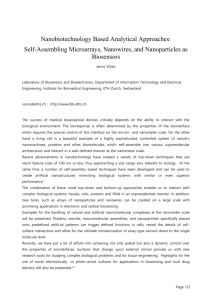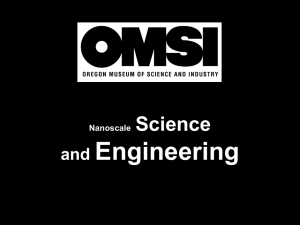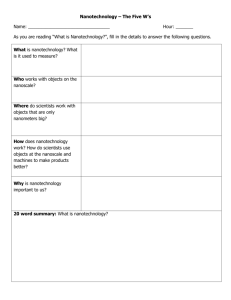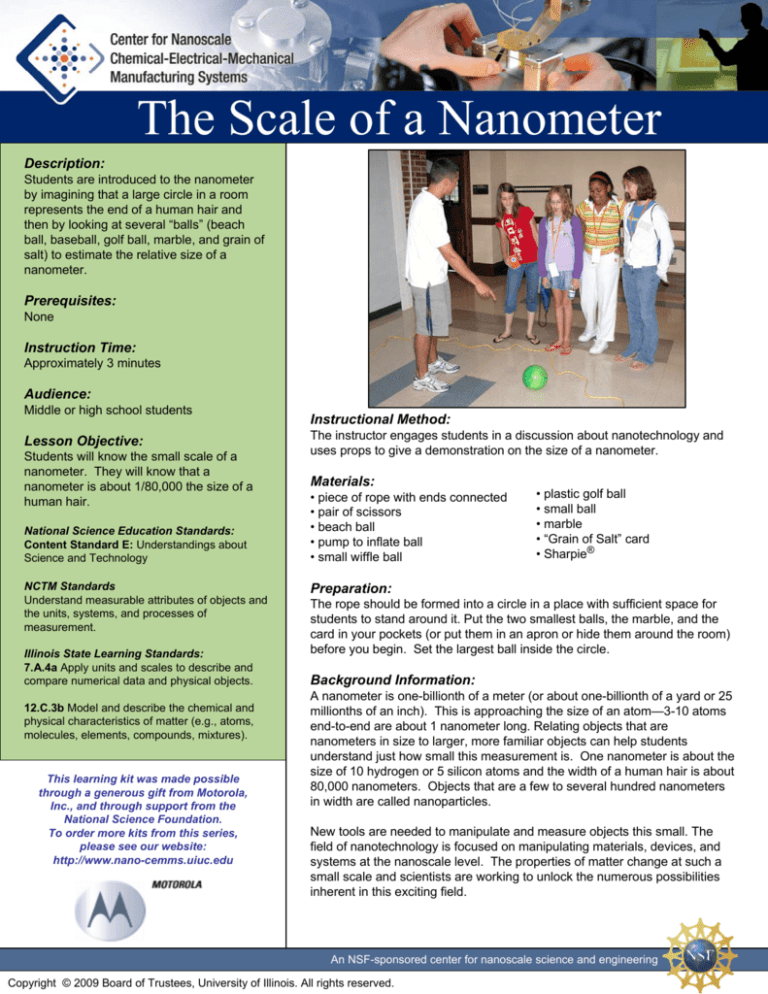
The Scale of a Nanometer
Description:
Students are introduced to the nanometer
by imagining that a large circle in a room
represents the end of a human hair and
then by looking at several “balls” (beach
ball, baseball, golf ball, marble, and grain of
salt) to estimate the relative size of a
nanometer.
Prerequisites:
None
Instruction Time:
Approximately 3 minutes
Audience:
Middle or high school students
Lesson Objective:
Students will know the small scale of a
nanometer. They will know that a
nanometer is about 1/80,000 the size of a
human hair.
National Science Education Standards:
Content Standard E: Understandings about
Science and Technology
NCTM Standards
Understand measurable attributes of objects and
the units, systems, and processes of
measurement.
Illinois State Learning Standards:
7.A.4a Apply units and scales to describe and
compare numerical data and physical objects.
12.C.3b Model and describe the chemical and
physical characteristics of matter (e.g., atoms,
molecules, elements, compounds, mixtures).
This learning kit was made possible
through a generous gift from Motorola,
Inc., and through support from the
National Science Foundation.
To order more kits from this series,
please see our website:
http://www.nano-cemms.uiuc.edu
Instructional Method:
The instructor engages students in a discussion about nanotechnology and
uses props to give a demonstration on the size of a nanometer.
Materials:
• piece of rope with ends connected
• pair of scissors
• beach ball
• pump to inflate ball
• small wiffle ball
• plastic golf ball
• small ball
• marble
• “Grain of Salt” card
• Sharpie®
Preparation:
The rope should be formed into a circle in a place with sufficient space for
students to stand around it. Put the two smallest balls, the marble, and the
card in your pockets (or put them in an apron or hide them around the room)
before you begin. Set the largest ball inside the circle.
Background Information:
A nanometer is one-billionth of a meter (or about one-billionth of a yard or 25
millionths of an inch). This is approaching the size of an atom—3-10 atoms
end-to-end are about 1 nanometer long. Relating objects that are
nanometers in size to larger, more familiar objects can help students
understand just how small this measurement is. One nanometer is about the
size of 10 hydrogen or 5 silicon atoms and the width of a human hair is about
80,000 nanometers. Objects that are a few to several hundred nanometers
in width are called nanoparticles.
New tools are needed to manipulate and measure objects this small. The
field of nanotechnology is focused on manipulating materials, devices, and
systems at the nanoscale level. The properties of matter change at such a
small scale and scientists are working to unlock the numerous possibilities
inherent in this exciting field.
An NSF-sponsored center for nanoscale science and engineering
Copyright © 2009 Board of Trustees, University of Illinois. All rights reserved.
Safety:
Involvement in this activity poses minimal safety issues.
Presentation Details:
Ask the students to gather around the circle and ask if they have ever heard of nanotechnology. Introduce
nanotechnology by saying that it is technology that works on a very small scale – the scale of atoms and
molecules. Explain to the students that "nano" means one-billionth and that a nanometer is one-billionth of a
meter. If necessary, remind them that a centimeter is one-hundredth of a meter and a millimeter is onethousandth of a meter.
Ask for a volunteer to donate a piece of hair (and tell them they can have it back!). Use the scissors to cut off
a strand from a student. Walk around the circle showing the students how small the end of the hair is. As
you do so, you can have one student put a small (1 mm) mark on the back of each student’s hand with a
Sharpie®. Tell the students to imagine that the end of the strand of hair has been enlarged to the size of the
circle and that they are standing outside the hair. Ask them how big a nanometer would be in relation to the 4
meter wide end of the “hair.” Pick up the playground ball from the center of the circle and ask if that is small
enough. Pull out a softball (or have someone pitch it to you) and ask if now we have a nanometer. Pull out
the golf ball from your pocket and repeat the question. Pull out a small colored ball and repeat the question.
Pull out a marble from another pocket. Finally pull out a black piece of construction paper with a grain of salt
glued on it and tell them that the grain represents how big a nanometer would be if a piece of hair was the
size of the 4 meter wide circle. Indeed, a human hair is about 80,000 nanometers wide! Mention that the
black mark on their hands is 1 million nanometers wide. To close, you can emphasize that this activity shows
just how small a nanometer is.
References:
IPSE, University of Wisconsin – Cutting It Down to Nano
http://mrsec.wisc.edu/Edetc/IPSE/educators/activities/cuttingNano.html
IPSE, University of Wisconsin – Rocks and Nanobots
http://mrsec.wisc.edu/Edetc/IPSE/educators/socImp1.html
Nanoscience and Technology at Los Alamos National Laboratory
http://www.lanl.gov/mst/nano/definition.html
Useful Website:
National Nanotechnology Initiative
http://www.nano.gov/
Established in 2003, the Center for Nanoscale Chemical-Electrical-Mechanical Manufacturing Systems (Nano-CEMMS) is
funded by the National Science Foundation. Partnering Institutions include the University of Illinois, North Carolina
Agriculture and Technical State University, Stanford University, University of Notre Dame, University of California – Irvine,
and Northwestern University. Researchers are developing a nanomanufacturing system that will build ultrahigh-density,
complex nanostructures. The Center’s research will ultimately result in a new way of working and has the potential to create
millions of jobs for American workers. Our nation’s school children must be prepared to assume the new roles that will be the
inevitable outcome of these emerging technologies.
This learning module is one of a series designed to interest middle and high school students in pursuing this new field. The
Center also offers ongoing professional development for teachers through a continuous series of workshops and institutes.
To sign up for a workshop or to order more learning modules, visit our website at http://www.nano-cemms.uiuc.edu.
For more information, contact: Center for Nanoscale Chemical-Electrical-Mechanical Manufacturing Systems; University of Illinois at
Urbana-Champaign, 4400 Mechanical Engineering Laboratory, 105 South Mathews Avenue, MC-244, Urbana, IL 61801
Phone: 217.265.0093 Email: nano-cemms@uiuc.edu Website: http://www.nano-cemms.uiuc.edu
University of Illinois • North Carolina A&T • Stanford • Notre Dame • University of California – Irvine • Northwestern



